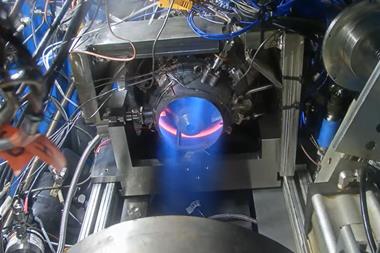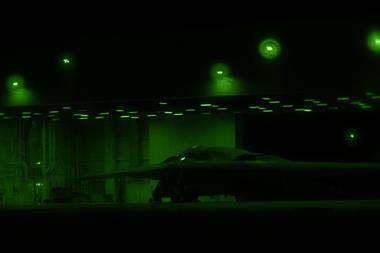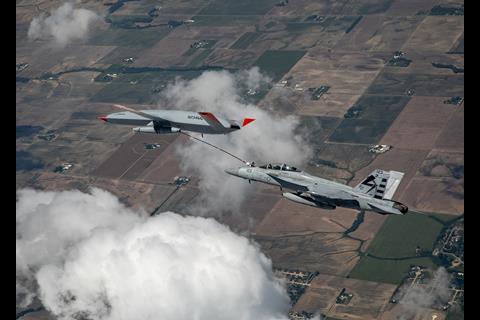The US Navy’s (USN’s) Boeing MQ-25 Stingray unmanned air vehicle (UAV) has demonstrated in-flight refuelling of an F/A-18F Super Hornet for the first time.
The demonstration marks the first time that a UAV has refuelled another aircraft, Boeing claims.
The unmanned in-flight refuelling tanker extended its hose and drogue from its aerial refuelling store and safely transferred 147kg (325lb) of fuel to the Super Hornet during two airborne tests on 4 June, Boeing and the USN announced on 7 June.
The MQ-25 is being developed to extend the range of carrier-based aircraft, such as the F/A-18 and the Lockheed Martin F-35C. The USN needs to be able to launch those aircraft further out from targets to keep its aircraft carriers out of the range of adversaries’ ballistic and cruise missiles.
The MQ-25 would also take over a buddy tanking role that the F/A-18 occasionally plays when it carries a hose and drogue to transfer fuel to other fighters. That would free up more aircraft in carrier-based fighter squadrons for combat missions.
Initial testing of the unmanned in-flight refuelling tanker is being done with the T1 test asset, a Boeing-owned MQ-25. The USN has seven of its own demonstration test articles on order for further testing and demonstrations. The first service-owned aircraft is scheduled for delivery in the fall or winter of 2022.
After initial delivery, the USN will test the MQ-25’s ability to do catapult launches and arrestments on the ground, before moving on to carrier-based launchings and landings. The service is aiming for the MQ-25 to reach initial operational capability in early 2025.
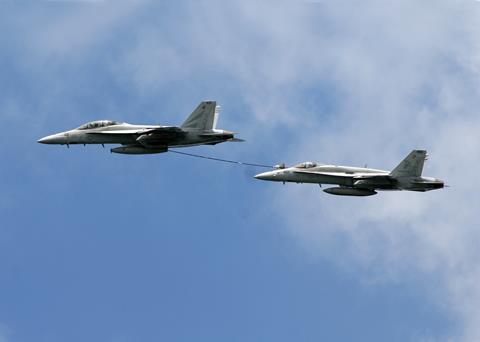
During the recent inaugural test, both aircraft were flying at “operationally relevant speeds and altitudes”, Boeing says, without disclosing additional details.
“During the initial part of the flight, the F/A-18 test pilot flew in close formation behind MQ-25 to ensure performance and stability prior to refuelling – a manoeuvre that required as little as [6.1m (20ft)] of separation between the MQ-25 T1 air vehicle and the F/A-18 refuelling probe,” the company says. “With the evaluation safely completed, the MQ-25 drogue was extended, and the F/A-18 pilot moved in to plug with the unmanned aircraft and receive the scheduled fuel offload.”
The in-flight refuelling demonstration comes after the T1 MQ-25 completed 25 flights during which the aerodynamics of the aircraft and aerial refuelling store were tested. Boeing and the USN say they have also been testing aerodynamics via digital models.
The USN plans to continue flight testing to expand the UAV’s flight envelope. Later this year, the service plans to ship the MQ-25 to Norfolk, Virginia, for deck handling trials aboard an aircraft carrier.
The demonstration of the MQ-25 passing fuel to the F/A-18F moves the USN one step closer to refuelling operations using UAVs. The US Department of Defense has been developing, testing and refining the process for years. In 2012, the Defense Advanced Research Projects Agency (DARPRA) demonstrated a Northrop Grumman RQ-4A Global Hawk flying close enough behind another RQ-4A at high altitude to refuel (However, the two UAVs never physically connected and no fuel was passed in that test). In 2015, the USN’s Northrop X-47B Unmanned Combat Air System Demonstration aircraft autonomously refuelled from an Omega Boeing K-707 tanker.
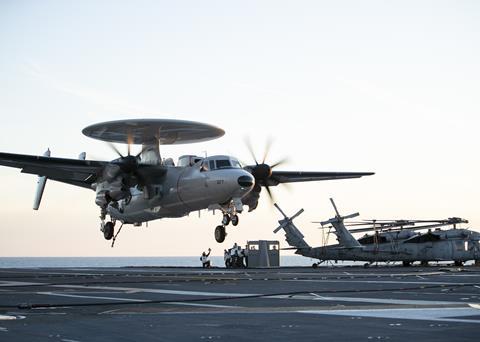
In March, the USN announced plans to award Northrop a sole-source contract to modify the E-2D Advanced Hawkeye’s mission computer and display software so that the early warning aircraft could control UAVs. The service also said in March it wanted to move some command-and-control activities of future carrier-based UAVs, such as the MQ-25A, off-ship via manned-unmanned teaming technologies.
The twin-turboprop E-2D carries an APY-9, a disc-shaped rotating radar dome that is used for early detection and tracking of aircraft and cruise missiles. It also has identification friend or foe capabilities, electronic support measures and sensors for target identification. The USN calls the five-crew aircraft a “digital quarterback” because of its role as a command-and-control station, as well as its ability to collect and pass information.
Indeed, though the MQ-25’s primary mission is in-flight refuelling, the USN sees other roles for the UAV, says Captain Chad Reed, programme manager for the unmanned carrier aviation office.
“It does have other systems on board, mission systems that can perform intelligence, surveillance and reconnaissance missions,” he says. “We can get some eyes and ears from MQ-25, and control those from somewhere else other than the carrier. That gives us a level of flexibility in warfare that the navy is very interested in and exploring.”
Article updated on 11 June to note that this appears to be the first time a UAV has conducted an in-flight refuelling of another aircraft. DARPA’s RQ-4A demonstration in 2012 did not pass fuel.





















